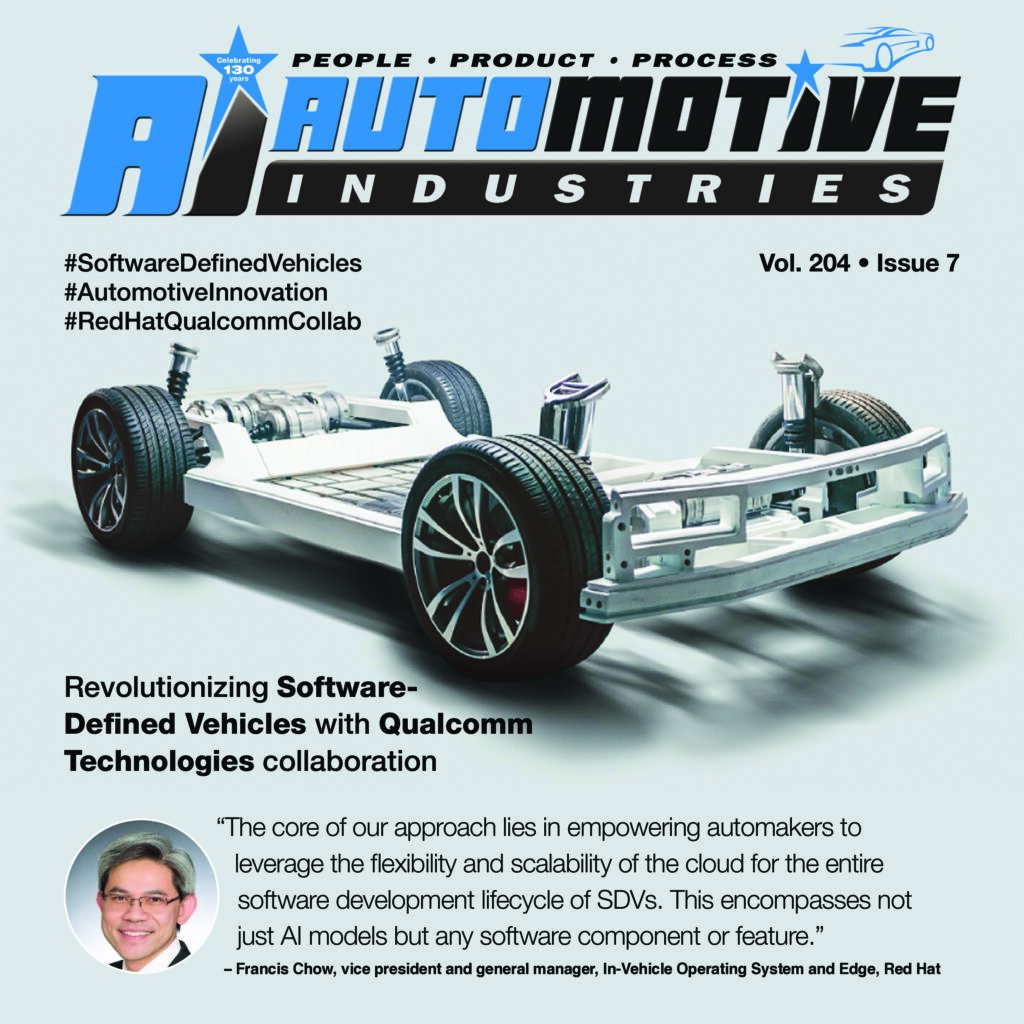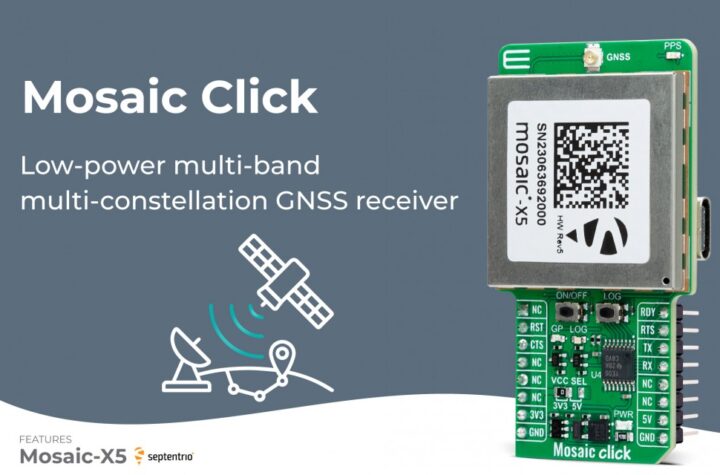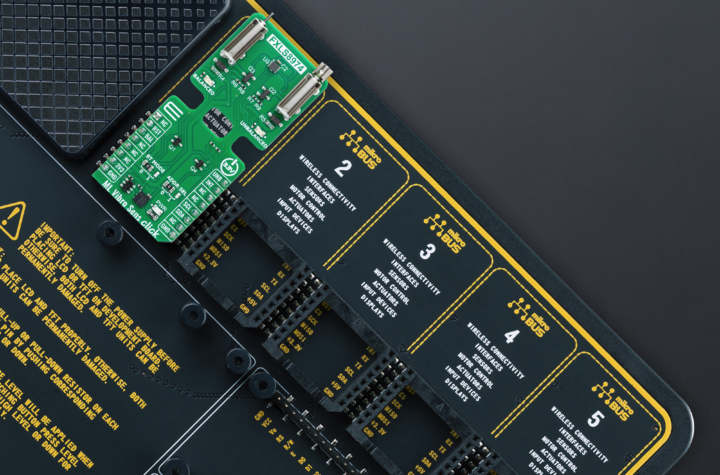
Automotive Industries interview with Francis Chow, vice president and general manager, In-Vehicle Operating System and Edge, Red Hat
As the automotive industry races towards a future defined by software, collaborations like the one between Red Hat and Qualcomm Technologies are driving this transformation with groundbreaking innovation. Francis Chow, Vice President and General Manager of In-Vehicle Operating System and Edge at Red Hat, provides an illuminating glimpse into this shared work, which is set to revolutionize software-defined vehicles (SDVs).
The genesis of this collaboration, as Chow recounts, took shape in 2022 when Red Hat and Qualcomm joined forces to develop functional-safety certified systems built on Linux. This initiative aimed to support mission-critical applications for automakers by integrating Red Hat In-Vehicle Operating System with Qualcomm’s Snapdragon Digital Chassis—a suite of cloud-connected platforms for telematics, connectivity, digital cockpits, and advanced driver-assistance systems (ADAS). The collaboration has now advanced to demonstrating and delivering a pre-integrated platform, underscoring a significant milestone towards realizing SDVs.
Red Hat’s contribution to this alliance is steeped in its legacy of open source innovation. By bringing open technologies to the automotive sector, Red Hat is helping the industry embrace open source solutions that promise to benefit the entire ecosystem. This open approach enables automakers to prototype software fixes, introduce new features, and roll out revenue-generating services in the cloud before deployment to vehicles, drastically enhancing efficiency and innovation.
On the other hand, Qualcomm’s Snapdragon Ride Flex System on Chip (SoC) and its AI capabilities are central to accelerating the development and deployment of SDV technologies. Automakers can utilize these technologies to prototype and validate AI models in the cloud, ensuring they are accurate and effective before being implemented in vehicles. This not only speeds up development cycles but also enhances safety and performance through rigorous cloud-based testing.
Chow elaborates on the key components of their platform, highlighting the unique integration of Red Hat In-Vehicle Operating System with Qualcomm’s hardware. This combination allows for cloud-native workloads and a microservices-based architecture, crucial for developing advanced driver assistance systems (ADAS). The approach facilitates containerized applications, which can be updated individually and efficiently, ensuring freedom from interference (FFI) required for mixed criticality in automotive systems.
A cornerstone of this collaboration is the capability for over-the-air (OTA) updates. Managing the security and reliability of these updates posed significant challenges, which Red Hat and Qualcomm addressed through a multi-layered security framework. This includes the use of GNU Privacy Guard (GPG) for signing Linux packages, Secure Boot for ensuring trusted software, and rigorous metadata verification, all of which fortify the integrity of OTA updates.
Moreover, the ability to prototype and validate AI models in the cloud exemplifies the broader impact of this work. This process improves the safety and efficiency of SDVs by enabling comprehensive testing in virtual environments. Red Hat’s platform supports this by providing a consistent environment for running containerized workloads, facilitating seamless integration from cloud to vehicle.
In essence, the collaboration between Red Hat and Qualcomm is a testament to the power of synergy in driving technological advancement. By merging their respective strengths—open source expertise and cutting-edge AI technology—they are paving the way for a new era in automotive innovation, where software-defined vehicles become the norm, and continuous, secure updates ensure they remain at the forefront of technological progress.
Automotive Industries interview with Francis Chow, vice president and general manager, In-Vehicle Operating System and Edge, Red Hat
Automotive Industries: Hi Francis, what sparked the collaboration between Red Hat and Qualcomm Technologies in the realm of software-defined vehicles (SDVs) and what unique value does each partner bring to the table?
Chow: In 2022, Red Hat and Qualcomm announced together that we were working to develop functional-safety certified systems built on Linux to support mission-critical applications for automakers by integrating and testing Red Hat In-Vehicle Operating System on Qualcomm’s Snapdragon Digital Chassis – a set of cloud-connected platforms for telematics and connectivity, digital cockpit and ADAS. With this latest announcement, we’re building on this collaboration by demonstrating and delivering a pre-integrated platform that will run on the Red Hat In-Vehicle Operating System for virtual testing and deployment in SDVs. This work between Red Hat and Qualcomm Technologies serves as another critical step in moving closer to the successful realization of SDVs. Now automakers will be able to better prototype software fixes, new features, and revenue-generating services in the cloud before deployment to the car.
From the Red Hat side, we’re bringing open technologies to the automotive world by helping them adapt and embrace open source concepts and solutions that will benefit the whole ecosystem, alongside our end customers.
Automotive Industries: The announcement mentions the demonstration and delivery of a pre-integrated platform for SDVs. Could you elaborate on the key components of this platform and how it differs from existing solutions in the market?
Chow: The components we’re looking at here are the Red Hat In-Vehicle Operating System and the Snapdragon Ride Flex SoC from Qualcomm.
Automakers will be able to use Qualcomm Technologies’ AI technologies and the Snapdragon Ride Flex SoC to accelerate the development and deployment of software fixes, new features and revenue-generating services for SDVs. With in-cloud emulation configurations, automakers can prototype and validate AI object detection models. These models can then be tested and refined in the cloud environment, confirming their accuracy and effectiveness before deployment to the vehicle. All of this is achievable via the open source platform of Red Hat In-Vehicle Operating System, enabling customers to receive automotive updates in the same way they upgrade applications or software on mobile devices.
Automotive Industries: Red Hat emphasizes the role of open source solutions in transforming the automotive industry. How does Red Hat ensure that its In-Vehicle Operating System remains adaptable and secure amidst rapid technological advancements and evolving industry standards?
Chow: Embracing open source is essential in realizing the vision of SDVs, while keeping pace with the innovation rate of the disruptors in the space. By working with customers, partners, and the broad open source ecosystem at large, Red Hat has been the leader in delivering innovation at pace for mission and business critical applications in multiple industries for over two decades. In addition, we have been leading by far with the most experts in Linux maintainers, providing assurance and oversight in the evolution of critical building blocks of open source Linux. Red Hat In-Vehicle Operating System benefits from the same people, pipeline and process that Fortune 500 enterprises rely upon, along with a tailored approach, working with experts in the functional safety and automotive security industry standards, to realize continuous safety certification of Linux for applications requiring ASIL-B level certification.
Automotive Industries: Could you explain how the collaboration between Red Hat and Qualcomm Technologies accelerates the development and deployment of advanced driver assistance systems (ADAS) applications in SDVs, particularly in terms of cloud-native workloads and microservices-based architecture?
Chow: The working integration we showcased at Red Hat Summit, demonstrated an ADAS use case implemented as a set of cloud native microservices that can be individually updated and deployed to the vehicle. The utility and efficiency of containerizing applications, while maintaining the ability to bolster freedom from interference (FFI), required in automotive mixed criticality configurations, is a hallmark of the innovative, tailored approach we are taking to deliver acceleration while maintaining the continuous safety certification capability SDV requires.
Automotive Industries: Over-the-air (OTA) updates are highlighted as a key feature enabled by the collaboration. What challenges did Red Hat and Qualcomm Technologies encounter in ensuring the security and reliability of OTA updates for vehicles, and how were these challenges addressed?
Chow: Here again, managing risk with software updates is key and by leveraging Red Hat’s cloud native toolchains, OEMs can break down vehicle software into containerized microservices. This approach simplifies development and testing and makes OTA updates more efficient and targeted. Instead of large updates, we can deliver smaller, specific updates to individual components as needed. The Red Hat Summit demo focused on demonstrating the feasibility of this technology collaboration and we are fully aware of the importance of security and reliability for OTA updates.
We have developed a comprehensive security strategy that will address critical concerns through a multi-layered security framework within Red Hat In-Vehicle Operating System. For OTA in particular, we utilize the GNU Privacy Guard (GPG) to sign the Linux packages such that tampering of the software packages through the network connection can be detected. Each package is signed with a private key and it is checked to verify the integrity and authenticity of the packages.
Furthermore, Repository metadata, which includes information about available packages and updates, is also signed with GPG. The package manager verifies the signature of this metadata before proceeding with the download and installation of packages. Of course, we also have Secure Boot as another form of defense that ensures that the system boots only with software that is trusted by the hardware, preventing booting with compromised bootloaders or kernels. Additionally, we have disk verification as another layer of protection to verify non-exectued data through checksum and hashes.
Automotive Industries: The Red Hat and Qualcomm announcement mentions the ability to prototype and validate AI object detection models in the cloud environment. How does this process contribute to improving the safety and efficiency of SDVs, and what role does Red Hat’s platform play in facilitating this development?
Chow: The ability to prototype and validate AI models in the cloud is just one example of the broader capabilities enabled by Red Hat and Qualcomm. The core of our approach lies in empowering automakers to leverage the flexibility and scalability of the cloud for the entire software development lifecycle of SDVs. This encompasses not just AI models but any software component or feature.
By developing and testing in the cloud, automakers gain enhanced safety through rigorous validation in virtual environments, increased efficiency through scalable testing and faster development cycles, and significant cost savings compared to traditional physical testing methods.
Red Hat’s offerings play a crucial role in facilitating this development by providing a consistent platform for running containerized workloads across different environments – from the cloud to the vehicle itself. This seamless integration enables automakers to develop and test software in the cloud and then deploy it to the vehicle with confidence.
This is what was demonstrated at Red Hat Summit. We showcased how automakers can leverage our platform to develop and test a wide range of software components, including AI object detection models, in the cloud and then seamlessly deploy them to the vehicle through OTA updates.
Automotive Industries: Collaboration with industry partners like Deloitte, ETAS, and General Motors is cited. Could you share any insights or lessons learned from these partnerships that have influenced the approach taken in the collaboration with Qualcomm Technologies?
Chow: It is critical to understand that no one company can effectively and efficiently deliver all that is required to innovate at pace and cover all of the aspects of functional safety and security necessary. It takes an ecosystem working together to take the initiative to create the working hardware/software blueprints that can accelerate the delivery of production SDV platforms and back end operations infrastructure. Working together with OEMs, in this transformation that requires a sea change in process, tools, talent and more, we are seeing a need for expertise in integration services and process retooling that pulls together hardware, operating systems, middleware, development and deployment tools, as well as process to help OEMs navigate this journey. More than ever, the value of pre-integrated technology and integration services our ecosystem is rapidly pulling together, is increasingly instrumental in realizing the SDV vision for our mutual customers.
Automotive Industries: Red Hat’s involvement in SDVs extends beyond technical solutions to include support, training, and consulting services. How does this comprehensive approach contribute to the successful adoption and implementation of SDVs by automotive manufacturers?
Chow: Red Hat’s comprehensive approach to SDVs goes beyond technology, recognizing that SDVs necessitate a shift in processes and culture within the automotive industry. By offering not only open source software solutions but also extensive support, comprehensive training and expert consulting services, Red Hat empowers automakers to successfully navigate this transformation. Red Hat’s experience helping other industries in their digital transformation, along with open source expertise makes us a valuable partner for the automakers as software becomes more important in vehicles.
Automotive Industries: Looking ahead, what are the key milestones or developments that Red Hat and Qualcomm Technologies aim to achieve in advancing the capabilities of SDVs, and how do you foresee these advancements shaping
Chow: We really cannot comment on Qualcomm’s milestones or future developments. From Red Hat’s point of view, we intend to work with partners to create a consistent end-to-end, vehicle-to-cloud infrastructure platform with consistent toolings to enable accelerated innovation for SDV. In addition to infrastructure, we are looking at productivity tools to help improve developer productivity of automakers and tier-1’s.














More Stories
Mosaic Click board from MIKROE delivers global coverage multi-band and multi-constellation tracking ability
Current transducer from Danisense selected for DC charging station testing device demonstrator at TU Graz
New Click board from MIKROE helps develop and train ML models for vibration analysis